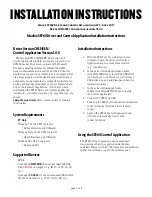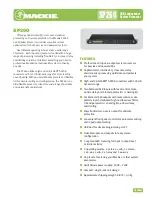
36 Installation
Cooling
The Electronic Loads can operate without loss of performance within the temperature range of 0
°
to 40
°
C, and with derated
performance from 40
°
to 55
°
C. However, you must install your Electronic Load in a location that allows sufficient space at
the top, sides, and rear of the unit for adequate air circulation. Variable-speed fans cool the unit by drawing in air through
the top and sides and exhausting it out the back. You must leave at least 1.5 cm (0.5 in.) space above the unit for adequate
air circulation. Note that the unit’s feet allow enough vertical space for air circulation when units are stacked.
Rack Mounting
The Agilent 6050A Electronic Load can be mounted in a standard 19-inch rack panel or cabinet. Rack mount kits are
available as Option 908 and 909 (with handles). Support rails are also required for rack mounting. These are normally
supplied with the cabinet and are not included with the rack mount options.
The Agilent 6051A Electronic Load can also be mounted in a standard 19-inch rack panel or enclosure using a Option 908
rack mount kit (see Figure 3-4). A rack mount kit for joining two half-rack units is available as Option 800. Option 800
must also be used if you are mounting other instruments next to an Agilent 6051A Electronic Load. Support rails are also
required for rack mounting. These are normally supplied with the cabinet and are not included with the rack mounting
options.
If you are installing equipment on top of your Electronic Load in the cabinet, use a filler panel above the unit to ensure
adequate space for air circulation. A lU panel (EIA Standard RS-310-C) as shown in Figure 3-4 is sufficient. If your
cabinet has a circulation fan, avoid installing the Electronic Load too close to the cabinet fan. The cabinet fan may restrict
the airflow required through the Electronic Load.
Figure 3-4. Rack Installation
Turn-On Checkout
The simplified turn-on checkout procedure in this section verifies that about 90% of the Electronic Load is operating
correctly. The Service Manual contains detailed performance and verification tests. Before turning on the Electronic Load,
make the following checks:
Summary of Contents for 6050A
Page 10: ......
Page 14: ......
Page 32: ......
Page 46: ...46 Installation Figure 3 12 Local Sensing Figure 3 13 Remote Sensing...
Page 47: ...Installation 47 Figure 3 14 Parallel Operation Figure 3 15 Zero Volt Loading...
Page 48: ......
Page 55: ...Local Operation 55 Figure 4 2 Recommended Programming Sequence...
Page 64: ......
Page 69: ...Remote Operation 69 Figure 5 1 Remote Programming Flowchart Sheet 1...
Page 70: ...70 Remote Operation Figure 5 1 Remote Programming Flowchart Sheet 2...
Page 74: ......
Page 78: ...78 Calibration Figure 6 2 Calibration Flowchart for A Modules...
Page 79: ...Calibration 79 Figure 6 2 Calibration Flowchart for A Modules continued...
Page 80: ...80 Calibration Figure 6 2 Calibration Flowchart for A Modules continued...
Page 85: ...Calibration 85 Figure 6 3 Calibration Flowchart for B Modules...
Page 86: ...86 Calibration Figure 6 3 Calibration Flowchart for B Modules continued...
Page 87: ...Calibration 87 Figure 6 3 Calibration Flowchart for B Modules continued...
















































